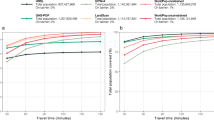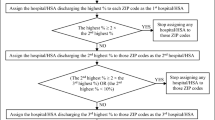Abstract
Geographic barriers to accessing timely and appropriate primary health care services have been identified as significant social determinants of health that contribute to the growing health inequities among Hispanic and Latino immigrants in the United States. The purpose of this study was to examine the geographic factors that serve as barriers to healthcare access for Hispanic and Latino immigrants in the southern community of Louisville, Kentucky. Accessibility to healthcare services was examined using spatial analysis techniques, a Geographic Information System and geographic data from the U.S. Census Bureau and the Louisville and Jefferson County Information Consortium. Results from this study indicated that physical location, socioeconomic factors, distance, and transportation served as barriers to accessing healthcare services. Findings provide significant implications for future research and policy-based interventions focused on eliminating geographic barriers and promoting social and health equity for the underserved.







Similar content being viewed by others
References
Derose KP, Escarce JJ, Lurie N. Immigrants and health care: sources of vulnerability. Health Affairs. 1989;26(5):1258–68.
Gresenz CR, Rogowski J, Escarce JJ. Community demographics and access to health care among U.S. Hispanics. Health Serv Res. 2009;44(5):1542–62.
Abraido-Lanza AF, Cespedes A, Daya S, et al. Satisfaction with health care among Latinas. J Health Poor Underserved. 2011;22(2):491–505.
Alcalde, G. Cross cultural community conversations: beginning the dialogue to understand the strengths and unmet needs of the Hispanic/Latino community in Louisville Metro. 2005. Available at http://www.louisvilleky.gov/OFW/Publications/Reports.htm.
Capps R, Fortuny K, Zimmermann W, et al. A profile of the foreign-born in the Louisville Metropolitan area. Washington, D.C: The Urban Institute; 2006.
Coffman MJ, Shobe MA, Dmochowski J, et al. Health care access and utilization among Latino immigrants. Hispanic Health Care International. 2007;5(2):73–80.
Harari N, Davis M, Heisler M. Strangers in a strange land: health care experiences for recent Latino immigrants in Midwest communities. J Health Poor Underserved. 2008;19(4):1350–67.
Cristancho S, Garces DM, Peters KE, et al. Listening to rural Hispanic immigrants in the Midwest: a community-based participatory assessment of major barriers to health care access and use. Qual Health Res. 2008;18(5):633–46.
Berdahl TA, Kirby JB, Stone RAT. Access to health care for nonmetro and metro Latinos of Mexican origin in the United States. Medical Care. 2007;45(7):647–54.
Khan S, Velazquez V, O’Connor C, et al. Health care access, utilization, and needs in a predominantly Latino immigrant community in Providence, Rhode Island. Med Health: Rhode Island. 2011;94(10):284–7.
Fennelly K. (2006). Listening to the experts: provider recommendations on the health needs of immigrants and refugees. J Cult Div. 2006;13(4):190–200.
City-Data.com. Louisville, Kentucky poverty rate data—information about poor and low income residents. Illinois: Advameg, Inc.; 2013.
White C.. New survey shows Louisville’s growing Hispanic population lacks access to health care. Louisville, KY: Courier-Journal.com, 2011.
Agency for Healthcare Research and Quality. 2010 National Healthcare Disparities Report. Rockville, MD: U.S. Department of Health and Human Services; 2010.
Migration Policy Institute. Kentucky factsheet on the foreign born: demographic and social characteristics. Washington, D.C: Migration Policy Institute; 2007.
Office of Policy Planning and Evaluation. Louisville Metro Health Status Report. Louisville, KY: Louisville Metro Department of Public Health and Wellness, 2012.
U.S. Census Bureau. Language use. Washington, DC: U.S. Census Bureau; 2010.
Center for Health Equity. Louisville metro health equity report: the social determinants of health in Louisville metro neighborhoods. Louisville, KY: Louisville Metro Department of Public Health and Wellness; 2012.
Legislative Research Commission. Immigration in Kentucky. Frankfort, Kentucky: Legislative Research Commission, 2002.
Gatrell AC. Geographies of health: an introduction. Maiden (MA): Blackwell Publishers; 2002.
ESRI. ArcGIC desktop: release 10. Redlands, CA: Environmental Systems Research Institute; 2011.
Louisville and Jefferson County Information Consortium. Jefferson County geodatabase files. Louisville, KY: LOJIC; 2012.
Robinson AH, Morrison JL, Muehrke PC, et al. Elements of cartography. 6th ed. New York: Wiley; 1995.
Jenks GF. The data model concept in statistical mapping. International Yearbook Cartography. 1967;7:186–90.
Albert DP, Gesler WM, Wittie PS. Geographic information system. In: Albert DP, Gesler WM, Levergood B, editors. Spatial analysis, GIS, and remote sensing applications in the health sciences. Chelsea MI: Ann Arbor Press; 2000.
Dulin MF, Tapp H, Smith HA, et al. A trans-disciplinary approach to the evaluation of social determinants of health in a Hispanic population. BMP Public Health. 2012;12:769–79.
Phillips RL, Kinman EL, Schnitzer PG, et al. Using geographic information systems to understand health care access. Arch Fam Med. 2000;9(19):971–8.
U.S. Department of Health and Human Services. HHS poverty guidelines. Washington, DC: USDHHS; 2012. p. 2012.
Census Bureau US. State and county quick facts. Washington, DC: U.S. Census Bureau; 2013.
Friedrich JM. Systemic barriers for Latina women accessing healthcare services in Louisville, Kentucky: an assessment of social indicators in order to disclose social injustices. (Doctoral Dissertation). ProQuest Dissertations and Theses, 2009.
National Council of La Raza. Overcoming immigrant barriers to coverage: options for health care when major programs don’t cut it. Washington, D.C: National Council of La Raza, 2011.
Keating S, Carlson B, Jimenez S, et al. Psychometric testing of the immigrant barriers to health care scale: Hispanic version. Nursing and Health Sciences. 2009;11(3):235–43.
Kaiser Commission on Medicaid and the Uninsured. Improving access to adult primary care in Medicaid: exploring the potential role of nurse practitioners and physician assistants. Washington, D.C: The Henry J. Kaiser Family Foundation, 2011.
Stange K, Sampson D. Nurse practitioners and physician assistants in the United States: current patterns of distribution and recent trends. Princeton, NJ: Robert Wood Johnson Foundation; 2010.
Grumbach K, Hart GL, Mertz E, et al. Who is caring for the underserved? A comparison of primary care physicians and nonphysician clinicians in California and Washington. Annals of Family Medicine. 2003;1(2):97–104.
Hansen-Turton T, Line L, O’Connell M, et al. The nursing center model of health Care for the Underserved. Philadelphia, PA: National Nursing Centers Consortium; 2004.
Office of Technology Assessment. Nurse practitioners, physician assistants and certified nurse midwives: a policy analysis. Washington, D.C: U.S. Congress, 1986.
White K, Haas JS, Williams DR. Elucidating the role of place in health care disparities: the example of racial/ethnic residential segregation. Health Serv Res. 2012;46(3):1278–99.
Acknowledgments
Kentucky Nurses Association.
Author information
Authors and Affiliations
Corresponding author
Ethics declarations
Funding
This study was funded by the Kentucky Nurses Foundation Research Grant program.
Conflict of Interest
The authors declare that they have no conflict of interest.
Ethical Approval
This article does not contain any studies with human participants or animals performed by any of the authors.
Rights and permissions
About this article
Cite this article
Edward, J., Biddle, D.J. Using Geographic Information Systems (GIS) to Examine Barriers to Healthcare Access for Hispanic and Latino Immigrants in the U.S. South. J. Racial and Ethnic Health Disparities 4, 297–307 (2017). https://doi.org/10.1007/s40615-016-0229-9
Received:
Revised:
Accepted:
Published:
Issue Date:
DOI: https://doi.org/10.1007/s40615-016-0229-9




